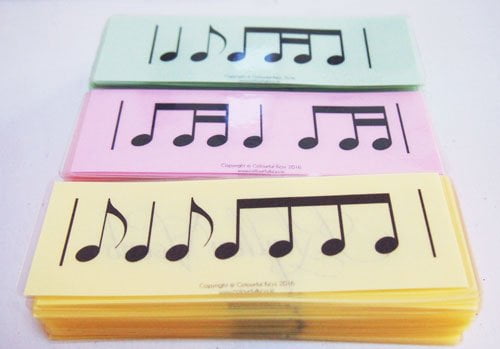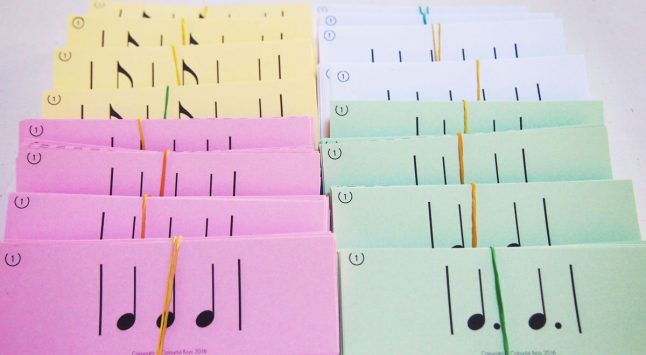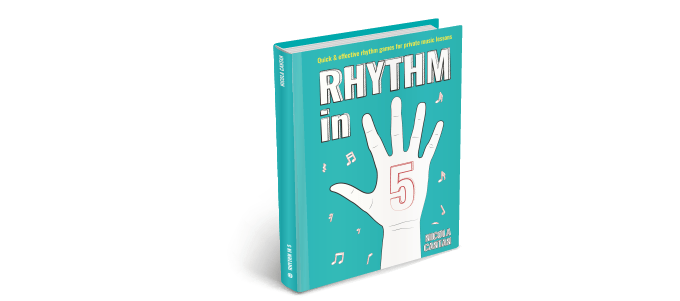Some students will always find rhythm to be the most challenging part of piano lessons. It’s also the most important part of music. So why should we leave it to chance and only teach rhythm when it comes up in pieces?

The content in this post was originally published in July 2016, February 2019, and June 2019. It was substantially updated with new content in June 2021.
When I first started out teaching piano, I did what most teachers tend to do: I waited for rhythm to come up in the repertoire and then helped my students through it.
As a result, my students developed a random hodgepodge of rhythm skills based solely on repertoire they happened to play. They weren’t connecting with the over-arching rhythmic concepts.
I wanted to be more proactive about rhythm. In the style of Kodály or Music Learning Theory, I believe students should be comfortable with a rhythm pattern long before they see it in their repertoire.
I wanted to have a clear progression of simple rhythms which students can internalise.
Now, instead of waiting for rhythms to appear in repertoire, I teach rhythm as a vocabulary of patterns using a series of rhythm vocab cards. I’ve found this to be the best solution, especially for students who struggle with rhythm.

Subscribe to the newsletter and get the RHYTHM VOCAB SAMPLE CARDS.
Enter your details to subscribe to the newsletter for piano teachers with information, tips and offers.
I hate spam as much as you do! I will only send you emails related directly to piano teaching and you can unsubscribe at any time.
Vibrant Music Teaching members can access all 4 sets of Rhythm Vocab Cards in the VMT library here: Level 1, Level 2, Level 3, and Level 4. Not a member yet? Find out more about becoming a member here.
Learning Objectives
The main purpose of these cards is to gradually build up a rhythm vocabulary during instrumental lessons. However, they could also be used for many other activities. They do not need to be used in order, and the complete sets do not have to be used together.
Just a note for all you eager beavers: If your Rhythm Vocabulary Cards are all ready to go, click here to jump straight to the part of this article where you can discover many fun ways to use them!
Assembly
There are 2 sets of rhythm cards in each level: one set is numbered, one is not. The rhythms themselves are identical; the numbers are simply there to help me track which cards a student has already mastered. You certainly don’t need to use the cards in this order.
To assemble:
- Print out the cards (either with or without reference numbers,) double-sided.
- Cut the cards apart along the dotted lines.
- Laminate if desired.
I like to print each level on a different colour. This way I can easily grab the ones I’m looking for, or sort them out if they get mixed up.

Want to really immerse yourself in all-things-rhythm? The latest and greatest can be found in the Rhythm section of my Music Theory hub page.
Concepts Covered
Rhythm Vocab Cards Level 1
Level 1 is geared towards late beginner/grade 1 students. The cards are all in 4:4 time.
Note/rest values included:
- Quavers (eighth notes)
- Crotchets (quarter notes)
- Dotted crotchets (dotted quarter notes)
- Minims (half notes)
- Crotchet rests (quarter rests)
Rhythm Vocab Cards Level 2
Level 2 is also geared towards late beginner/grade 1 students, but the cards are all in 3:4 time. A wider variety of note and rest values are introduced in Level 2.
Note/rest values included:
- Semiquavers (sixteenth notes)
- Quavers (eighth notes)
- Quaver triplets (eighth note triplets)
- Crotchets (quarter notes)
- Dotted crotchets (dotted quarter notes)
- Minims (half notes)
- Tied crotchets (tied quarter notes)
- Quaver rests (eighth rests)
- Crotchet rests (quarter rests)
- Minim rests (half rests)
Rhythm Vocab Cards Level 3
Level 3 Rhythm Vocab Cards boost the difficulty a bit to early intermediate/grade 2 students. The time signature is 4:4 for all the cards in this level.
Note/rest values included:
- Semiquavers (sixteenth notes)
- Quavers (eighth notes)
- Dotted quavers (dotted eighth notes)
- Quaver triplets (quaver eighths)
- Crotchets (quarter notes)
- Dotted crotchets (dotted quarter notes)
- Minims (half notes)
- Quaver rests (eighth rests)
- Crotchet rests (quarter rests)
- Minim rests (half rests)
Rhythm Vocab Cards Level 4
Level 4 is also aimed towards those early intermediate/grade 2 students, but the time signature is 6:8.
Note/rest values included:
- Semiquavers (sixteenth notes)
- Quavers (eighth notes)
- Dotted quavers (dotted eighth notes)
- Crotchets (quarter notes)
- Dotted crotchets (dotted quarter notes)
- Quaver rests (eighth rests)
- Crotchet rests (quarter rests)
How to Use
Since rhythm is the most important part of music, it’s vital that we find lots of ways to teach rhythm patterns to our students. By having lots of tricks up your sleeve (like those found in my book Rhythm in 5), you’ll be able to work on rhythm skills week-after-week without it grating on your students.
Here are just a few ways I help my students build a solid rhythmic foundation by using rhythm vocab cards.
Rhythm Exercises: Clap, Tap, Say or Play
Lay out a selection of cards in a line to create rhythm exercises for your students to clap, tap, say, count, or play. You can of course also use any form of counting you prefer, but I personally use rhythm syllables for all beginners (Ta, Ti, Ta-i and so on.)
There are many variations on this set of rhythm syllables, but they all come down to two things: they’re easier to say and sing than numbers, and they’re easier to understand than numbers.
After some time, I do teach metric counting, but we don’t ever leave the rhythm syllables behind. We continue to use both systems and my students can switch back and forth with ease. Working in this way I find my students have a much better understanding and feeling for rhythm patterns.
Rhythm Memory
I attended a fantastic Kodály training week here in Dublin a few years ago. In one of the many wonderful activities, the teacher laid out a series of single bars of 4:4 rhythms on the floor. We clapped/tapped these rhythms while saying the rhythm syllables. The teacher then turned over two of these bars at a time so that they had to be clapped from memory. We did this exercise several times over the course of the week.

It was tough for some at the beginning (there was a wide range of backgrounds and levels in the class.) But as the week went on, you could see the rhythmic patterns were really starting to sink in.
Aural Rhythm Bingo
- Lay out 8 of the numbered cards face up on the floor in a grid
- Each player draws their own tic-tac-toe grid and fills in the squares with the numbers from the rhythm vocab cards on the floor. (They can put the numbers in any order, use some twice or some not at all.)
- Player 1 claps one of the rhythm cards. If Player 2 can identify the correct card and that card is on her tic-tac-toe board, she can cross it off.
- Players take turns clapping patterns for each other until one player gets a bingo (3-in-a-row).
Improvisation
Improvisation is one of my most valuable tools to teach rhythm patterns to my piano students. Here are just a couple of ways you can use improvisation to teach rhythm patterns creatively.
Random Rhythms
- Have your student select 2 rhythm vocab cards at random.
- Tap, clap, stamp and chant this rhythm together.
- Teach your student a simple chord progression such as I-V-vi-IV.
- Have them play the selected rhythm in the right hand using chords (or 5ths, 3rds etc) while the left hand plays the root notes held for the full bar (measure).
- Improvise over the top while they play, then swap places and you play the chord progression while they improvise.
Cut and Paste From Pieces
- Look ahead to a piece your student will be learning soon.
- Take out a rhythm pattern which repeats throughout the piece, or choose a particularly tricky rhythm section.
- Teach your student this rhythm pattern without any reference to the notation, using Kodály or other rhythm syllables.
- Tap, stomp and clap this rhythm together.
- Play a simple chord progression in the key of the upcoming piece while your student improvises using the matching scale and the rhythm pattern you have been practising. (They can play any notes from the scale but must repeat that same rhythm pattern.)
- At the next lesson, introduce the notation by adding in the rhythm vocab cards which correspond to that pattern.
Now when you get to the new piece, your student gets to see the rhythm they already know in the context of the larger piece. They’ve already experienced the pattern and felt it and used it – so they’ll have much more success with it.
Composition
Ask your student to select 4 cards and put them in an order. Then compose a piece together using that rhythm as the starting point.
Tests
Here are 2 ways rhythm vocabulary cards can help with testing:
- Use a selection of cards to test a transfer student’s rhythm knowledge.
- Have students select cards at random to practise the “clapping at sight” test for an upcoming exam.

Subscribe to the newsletter and get the RHYTHM VOCAB SAMPLE CARDS.
Enter your details to subscribe to the newsletter for piano teachers with information, tips and offers.
I hate spam as much as you do! I will only send you emails related directly to piano teaching and you can unsubscribe at any time.
Vibrant Music Teaching members can access all 4 sets of Rhythm Vocab Cards in the VMT library here: Level 1, Level 2, Level 3, and Level 4. Not a member yet? Don’t miss out on all the exciting resources inside the membership!
How do you teach rhythm skills to your students?
I’d love to hear your favourite rhythm-boosting activities in the comments below.

Hi , thanks for this post. I use this as a rhythm challenge at the beginning of lessons for this term – I call it “take aways”.
Other time signatures would be great, compound times. Triplets, dullest and syncopation too.
Thank you for this post – syncopation would be lovely. Also tied notes, if possible
Thank you for sharing this great resource.